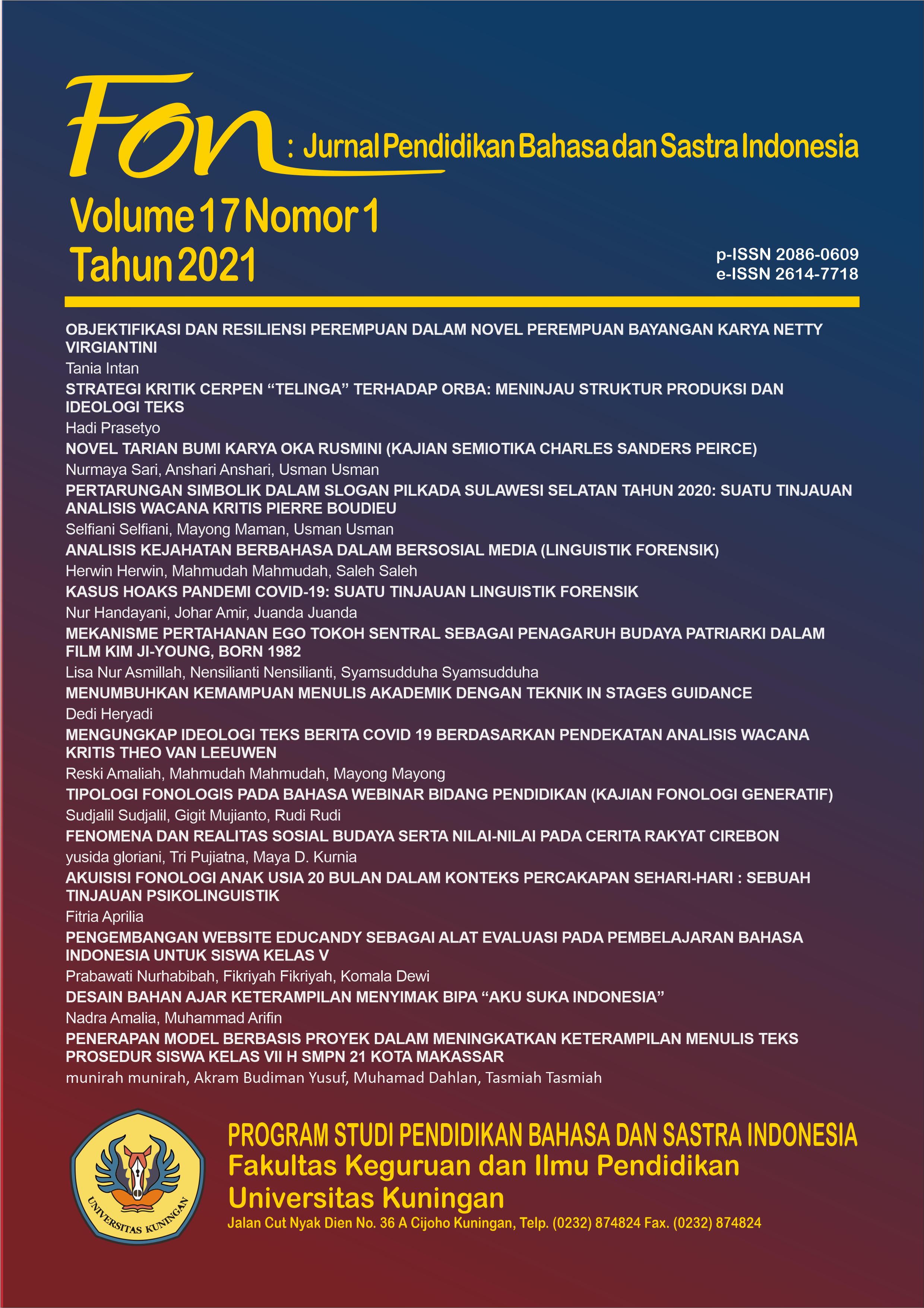AKUISISI FONOLOGI ANAK USIA 20 BULAN DALAM KONTEKS PERCAKAPAN SEHARI-HARI : SEBUAH TINJAUAN PSIKOLINGUISTIK
Abstract
ABSTRAK: Penelitian ini bertujuan untuk menggambarkan akuisisi/pemerolehan bahasa pada anak usia 20 bulan (1.8 tahun) ditinjau dari aspek fonologi yang meliputi pemerolehan fonem konsonan, vokal, dan diftong. Studi ini dilakukan di Palembang pada bulan Juli 2021. Metode yang digunakan dalam penelitian ini adalah metode kualitatif melalui pendekatan studi kasus. Data dalam penelitian ini diperoleh dari seorang anak laki-laki dengan inisial MDA sebagai responden. Teknik pengumpulan data dalam studi ini yaitu berupa vobservasi dan rekam. Berdasarkan hasil analisis diketahui bahwa responden telah mampu menghasilkan beberapa bunyi atau fonem yang ada dalam bahasa Indonesia. Fonem-fonem yang diproduksi terdiri dari fonem konsonan yang sudah muncul sebanyak 9 fonem yaitu /p/, /b/, /t/, /d/, /m/, /n/, /ŋ/, /w/, /y/. Responden juga telah mampu menghasilkan fonem vokal /a/, /i/, /u/, /e/, dan /o/. Bunyi vokal rangkap (diftong) seperti /au/, /ai/, /ue/, dan /ua/ juga telah dikuasai oleh responden.
KATA KUNCI: fonem (konsonan, vokal, dan diftong), fonologi, pemerolehan bahasa
PHONOLOGY AQUISITION OF A 20 MONTHS BABY IN DAILY CONVERSATION CONTEXT : A PSYCHOLINGUISTICS STUDY
ABSTRACT: The aim of this research is to describe the language acquisition of a child by the age of 20 months / 1.8 years old, seen from the phonological aspects such as phonemes of consonants, vowels, and diphthongs. This research was conducted in Palembang, on July 2021. The method used in this research was qualitative method through case study approach. The data were obtained from a young boy namely MDA as the respondent. The techniques of collecting the data in this research were through observation and recording. The results of the analyses show that the respondent has mastered various phonemes exist in Bahasa Indonesia. These phonemes consist of 9 consonants which are /p/, /b/, /t/, /d/, /m/, /n/, /ŋ/, /w/, /y/. The respondent also has been able to produce the vowel phonemes such as /a/, /i/, /u/, /e/, and /o/. Besides that, it was also found some kinds of diphthongs which are /au /, /ai/, /ue/, and /ua/.
KEYWORDS: phonemes (consonants, vocals, diphthongs), phonology, language acquisition
References
Alduais. A.M.S. (2015). An account of phonetics and phonology as similar identical or different. The International Journal of Indian Psychology, 3(1), 157-165.
Amaro, J. C., & Wrembel, M. (2016). Investigating the acquisition of phonology in a third language – a state of the science and an outlook for the future. International Journal of Multilingualism, 13(4), 395-409.
Broselow, E., & Xu, Z. (2004). Differential difficulty in the acquisition of second language phonology. International Journal Of English Studies, 4(2), 135-163.
Brown, D. (2007). Principles of learning and teaching. New Jersey: Prentice Hand Reagent.
Dardjowidjojo, S. (2000). Echa: Kisah Pemerolehan Bahasa Anak Indonesia. Jakarta: Grasindo.
Johson, C. E., & Wilson, I. L. (2002). Phonetic evidence for early language differentiation: Research issues and some preliminary data. The International Journal of Bilingualism, 6(3), 271-289.
Ladd, D. R. (2011). Phonetics in Phonology. Wiley-Blackwell, Chichester.
Mukalel, J. C. (2003). Psychology of Language Learning. New Delhi: Discovery Publishing House.
Pierce, L. J., Genesee, F., & Paradis, J. (2012). Acquisition of English grammatical morphology by internationally adopted children from China. International Journal of Child Language, 1(1), 1-15.
Sams, C. D. (2015). T/V pronouns in L2 acquisition of Spanish. International Journal of Language and Linguistics, 3(3), 182-186.
Sinha, A., Banerjee, N., Sinha, A., & Shastri, R. K. (2009). Interference of first language in the acquisition of second language. Journal of Psychology and Counseling, 1(7),117-122.
Steinberg, D. D., Nagata, H., & Aline, D.P. (2001). Psycholinguistics Language, Mind and World. New York: Longman
Sypianska, J. (2016). Multilingual acquisition of vowels in L1 Polish, L2 Danish and L3 English. International Journal of Multilingualism, 13(4), 476-495.
Copyright (c) 2021 Fon: Jurnal Pendidikan Bahasa dan Sastra Indonesia

This work is licensed under a Creative Commons Attribution-ShareAlike 4.0 International License.
INDONESIA: Jurnal Pembelajaran Bahasa dan Sastra Indonesia is licensed under a Creative Commons CC-BY-SA.


